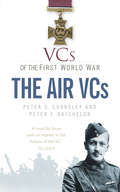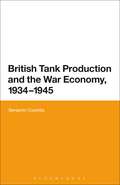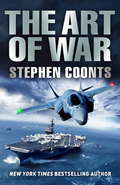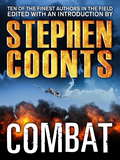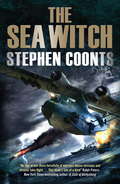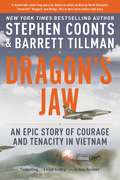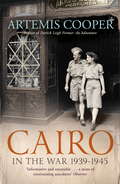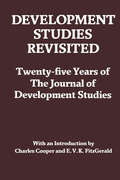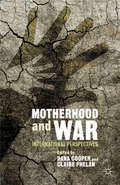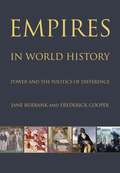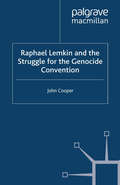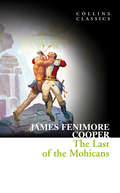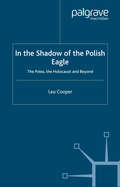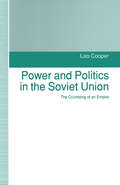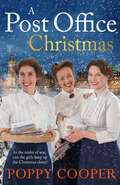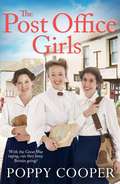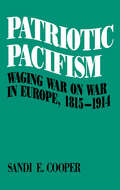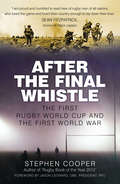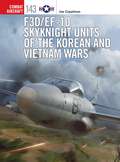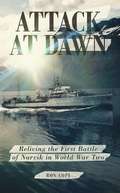- Table View
- List View
VCs of the First World War: Air Vcs (Vcs Of The First World War Ser.)
by Peter G. Cooksley Peter F. BatchelorOf more than 600 Victoria Crosses awarded to British and Empire servicemen during the First World War, nineteen were awarded to airmen of the newly formed Royal Flying Corps and Royal Naval Air Service. Of these, four were posthumous awards and all but one of the total were to officers. Some of these valorous airmen were from humble backgrounds and with limited education, others were collegiate men from wealthy families, but in the words of one senior officer they all had in common ‘the guts of a lion’.
British Tank Production and the War Economy, 1934-1945
by Benjamin CoombsBritish Tank Production and the War Economy, 1934-1945 explores the under-researched experiences of the British tank industry in the context of the pressures of war. Benjamin Coombs explores the various demands placed on British industry during the Second World War, looking at the political, military and strategy pressures involved. By comparing the British tank programme with the Canadian, American, Russian and Australian equivalents, this study offers an international perspective on this aspect of the war economy. Topics covered include the premature contraction of the tank programme and dependence on American armour, the supply of the Valentine tank to the Russian authorities and the ongoing employment of the tank in the postwar peacetime markets.
British Tank Production and the War Economy, 1934-1945
by Benjamin CoombsBritish Tank Production and the War Economy, 1934-1945 explores the under-researched experiences of the British tank industry in the context of the pressures of war. Benjamin Coombs explores the various demands placed on British industry during the Second World War, looking at the political, military and strategy pressures involved. By comparing the British tank programme with the Canadian, American, Russian and Australian equivalents, this study offers an international perspective on this aspect of the war economy. Topics covered include the premature contraction of the tank programme and dependence on American armour, the supply of the Valentine tank to the Russian authorities and the ongoing employment of the tank in the postwar peacetime markets.
The Art Of War (Jake Grafton #6)
by Stephen CoontsIN THE LATEST BLOCKBUSTER FROM THE NEW YORK TIMES BESTSELLING AUTHOR, JAKE GRAFTON FACES A NIGHTMARE THREAT FROM A CHINESE SLEEPER CELL.While the US navy is distracted by hostile activity in the South China Sea, a nuclear weapon has been planted in the harbour of Norfolk, Virginia - the world's largest naval base. Jake Grafton, promoted to director of the CIA following the murder of his predecessor, is unaware of the insidious plot. Though he has received intelligence informing him that an attack is imminent.He does not know where. He does not know when. But he does know who to turn to in a time of crisis.Faced with the horror of a disaster that would eclipse Pearl Harbor in scale, Jake and his right-hand man Tommy Carmellini return in this explosive race-against time thriller.Loved The Art of War? Then read Flight of the Intruder, and join Jake Grafton and Tommy Carmellini from the very beginning . . .
Combat: 18-copy Mass Market Mixed Floor Display (Stephen Coonts' Combat Ser. #1)
by Stephen CoontsCombat brings the best military fiction authors together to imagine how war will be fought in the twenty-first century. From the down and dirty 'ground-pounders' of the U.S. Armored Cavalry to new frontiers of warfare, including outer space and cyber warfare, ten authors whose novels define the military fiction genre have written short stories that also celebrate the men and women who put their lives on the line for freedom.
The Sea Witch: Three Novellas
by Stephen CoontsAirplanes, adventures, life and death in the skies: The Sea Witch brings together three dramatic tales - from three periods of history - of men and women at war: The Sea Witch: A rookie WW2 seaplane pilot is thrown in at the deep end on a mission to locate a missing colleague during the Battle of Guadalcanal. The 17th Day: Seventeen days is the average life expectancy of a British aviator during WW1. Today is Paul Hyde's seventeenth day. Will he live to see the next? Al-Jihad: 2001 - an ex-US Marine becomes caught up in a rogue plot to avenge the terrorists who killed his former commander. This collection, born of Coonts's lifelong passion for military aviation, shows his trademark storytelling at its most scintillating, passionate and powerful.
Dragon's Jaw: An Epic Story of Courage and Tenacity in Vietnam
by Stephen Coonts Barrett TillmanA riveting Vietnam War story--and one of the most dramatic in aviation history--told by a New York Times bestselling author and a prominent aviation historianEvery war has its "bridge"--Old North Bridge at Concord, Burnside's Bridge at Antietam, the railway bridge over Burma's River Kwai, the bridge over Germany's Rhine River at Remagen, and the bridges over Korea's Toko Ri. In Vietnam it was the bridge at Thanh Hoa, called Dragon's Jaw.For seven long years hundreds of young US airmen flew sortie after sortie against North Vietnam's formidable and strategically important bridge, dodging a heavy concentration of anti-aircraft fire and enemy MiG planes. Many American airmen were shot down, killed, or captured and taken to the infamous "Hanoi Hilton" POW camp. But after each air attack, when the smoke cleared and the debris settled, the bridge stubbornly remained standing. For the North Vietnamese it became a symbol of their invincibility; for US war planners an obsession; for US airmen a testament to American mettle and valor.Using after-action reports, official records, and interviews with surviving pilots, as well as untapped Vietnamese sources, Dragon's Jaw chronicles American efforts to destroy the bridge, strike by bloody strike, putting readers into the cockpits, under fire. The story of the Dragon's Jaw is a story rich in bravery, courage, audacity, and sometimes luck, sometimes tragedy. The "bridge" story of Vietnam is an epic tale of war against a determined foe.
Cairo in the War: 1939-45
by Artemis CooperFor troops in the desert, Cairo meant fleshpots or brass hats. For well-connected officers, it meant polo at the Gezira Club and drinks at Shepheard's. For the irregular warriors, Cairo was a city to throw legendary parties before the next mission behind enemy lines. For countless refugees, it was a stopping place in the long struggle home. The political scene was dominated by the British Ambassador Sir Miles Lampson. In February 1942 he surrounded the Abdin Palace with tanks and attempted to depose King Farouk. Five months later it looked as if the British would be thrown out of Egypt for good. Rommel's forces were only sixty miles from Alexandria - but the Germans were pushed back and Cairo life went on. Meanwhile, in the Egyptian Army, a handful of young officers were thinking dangerous thoughts.
Development Studies Revisited: Twenty-five Years of the "Journal of Development Studies"
by Charles Cooper E. V. FitzGeraldFirst published in 1989. The Journal of Development Studies was founded 25 years ago as a professional journal for what had by then become an established sub-discipline within British social science. The Journal has consistently published a broad spectrum of British research on development studies - a catholicity that has been reflected in the composition of the Editorial Board over the years - and has always welcomed authors from the USA, the European Continent, and above all from the Third World. Collated form the last twenty-five years of the journal presented here are a collection of 20-odd papers that represent less than three per cent of articles published since 1964.
Development Studies Revisited: Twenty-five Years of the "Journal of Development Studies"
by Charles Cooper E. V. FitzGeraldFirst published in 1989. The Journal of Development Studies was founded 25 years ago as a professional journal for what had by then become an established sub-discipline within British social science. The Journal has consistently published a broad spectrum of British research on development studies - a catholicity that has been reflected in the composition of the Editorial Board over the years - and has always welcomed authors from the USA, the European Continent, and above all from the Third World. Collated form the last twenty-five years of the journal presented here are a collection of 20-odd papers that represent less than three per cent of articles published since 1964.
Motherhood and War: International Perspectives
by Dana Cooper Claire PhelanTraditional histories of war have typically explored masculine narratives of military and political action, leaving private, domestic life relatively unstudied. This volume expands our understanding by looking at the relationships between mothers and children, and the varied roles both have assumed during periods of armed conflict.
Empires in World History: Power and the Politics of Difference
by Frederick Cooper Jane BurbankHow empires have used diversity to shape the world order for more than two millenniaEmpires—vast states of territories and peoples united by force and ambition—have dominated the political landscape for more than two millennia. Empires in World History departs from conventional European and nation-centered perspectives to take a remarkable look at how empires relied on diversity to shape the global order. Beginning with ancient Rome and China and continuing across Asia, Europe, the Americas, and Africa, Jane Burbank and Frederick Cooper examine empires' conquests, rivalries, and strategies of domination—with an emphasis on how empires accommodated, created, and manipulated differences among populations.Burbank and Cooper examine Rome and China from the third century BCE, empires that sustained state power for centuries. They delve into the militant monotheism of Byzantium, the Islamic Caliphates, and the short-lived Carolingians, as well as the pragmatically tolerant rule of the Mongols and Ottomans, who combined religious protection with the politics of loyalty. Burbank and Cooper discuss the influence of empire on capitalism and popular sovereignty, the limitations and instability of Europe's colonial projects, Russia's repertoire of exploitation and differentiation, as well as the "empire of liberty"—devised by American revolutionaries and later extended across a continent and beyond.With its investigation into the relationship between diversity and imperial states, Empires in World History offers a fresh approach to understanding the impact of empires on the past and present.
Raphael Lemkin and the Struggle for the Genocide Convention
by J. CooperThis book is the first complete biography of Raphael Lemkin, the father of the United Nations Genocide Convention, based on his papers; and shows how his campaign for an international treaty succeeded. In addition, the book covers Lemkin's inauguration of the historical study of past genocides.
The Deerslayer
by James Fenimore CooperBook Description In this final volume in the Leatherstocking saga, the Indian-raised Deerslayer has become a man of courage and moral certainty-and he emerges from tribal warfare with nobility as pure and proud as the wilderness whose fierce beauty and freedom have claimed his heart.
The Last of the Mohicans: A Narrative Of 1757 (Collins Classics)
by James Fenimore CooperHarperCollins is proud to present its range of best-loved, essential classics.
In the Shadow of the Polish Eagle: The Poles, the Holocaust and Beyond
by L. CooperThe behaviour of many Poles towards the Jewish population during the Nazi occupation of Poland has always been a controversial issue. Although the Poles are supposed not to have collaborated with the invaders, there is evidence to show that in respect of the Jewish population, the behaviour of many Poles, including members of the underground, was far from exemplary. Poland is also the only European country where Jews were being murdered after the end of the war and where strong anti-Semitic tendencies are still present. This book analyses this question in an historical context and attempts to offer an explanation for the phenomenon of Polish anti-Semitism during and after the end of the war. The work is based on recently uncovered documents as well as on personal accounts of witnesses to the events during the war.
Power and Politics in the Soviet Union: The Crumbling of an Empire
by Leo CooperAnalyzes the nature of power in the USSR and its evolution since the Bolshevik Revolution. The main thrust of this work, however, is in tracing the fragmentation of power since Gorbachev introduced his reforms and examining the changes in the power structure as a result of perestroika.
A Post Office Christmas: Book Two in a lively, uplifting new WW1 saga series
by Poppy CooperCurl up with the perfect festive saga read! Can they deliver hope and friendship this Christmas? 1915. After the recent dramatic events at the Home Depot, Milly Woods is looking forward to spending as much time as possible with her Post Office girls, Nora and Beth - known as Liza to her friends. With Christmas fast approaching, their job of getting millions of letters and parcels to the troops on the front line is more important than ever.But when Milly is moved to a different department, she and the girls struggle to find time to spend together. Feeling more and more lonely, Milly finds company and common ground at her local suffragette group - as well as catching the eye of a wounded ex-soldier at the Home Depot.But soon, Milly discovers that her new friends might not be what they seem. As she is drawn into a deadly plan that could affect the outcome of the war, can her Post Office girls help her get back on track, and scupper the plan in time for Christmas?READERS LOVE THE POST OFFICE GIRLS!'A superb debut novel' - 5 STARS'Entertaining, enlightening and thoroughly enjoyable' - 5 STARS'I absolutely loved this book and I am already eagerly awaiting book two in the series' - 5 STARS'The book gave a wonderful in sight into postal-service life during the war. Well done, Poppy' - 5 STARS'An excellent WW1 book' - 5 STARS
The Post Office Girls: Book One in a heartwarming and uplifting new wartime saga series
by Poppy CooperWith the Great War raging, can they keep Britain going? 1915. On Beth Healey's eighteenth birthday, she hopes that she will be able to forget the ghastly war and celebrate. But that evening, her twin brother Ned announces that he has signed up to fight. No longer able to stand working in her parents' village shop while others are doing their bit, Beth applies to join the Army Post Office's new Home Depot on the Regent's Park, and is astounded to be accepted. She will be responsible for making sure that letters and parcels get through to the troops on the front line. Beth is thrilled to be a crucial part of the war effort and soon makes friends with fellow post girls Milly and Nora, and meets the handsome James. But just as she begins to feel that her life has finally begun, everything starts falling apart, with devastating consequences for Beth and perhaps even the outcome of the war itself. Can Beth and her new friends keep it all together and find happiness at last?
Patriotic Pacifism: Waging War on War in Europe, 1815-1914
by Sandi E. CooperDespite the liberalized reconfiguration of civil society and political practice in nineteenth-century Europe, the right to make foreign policy, devise alliances, wage war and negotiate peace remained essentially an executive prerogative. Citizen challenges to the exercise of this power grew slowly. Drawn from the educated middle classes, peace activists maintained that Europe was a single culture despite national animosities; that Europe needed rational inter-state relationships to avoid catastrophe; and that internationalism was the logical outgrowth of the nation-state, not its subversion. In this book, Cooper explores the arguments of these "patriotic pacifists" with emphasis on the remarkable international peace movement that grew between 1889 and 1914. While the first World War revealed the limitations and dilemmas of patriotic pacifism, the shape, if not substance, of many twentieth-century international institutions was prefigured in nineteenth-century continental pacifism.
Patriotic Pacifism: Waging War on War in Europe, 1815-1914
by Sandi E. CooperDespite the liberalized reconfiguration of civil society and political practice in nineteenth-century Europe, the right to make foreign policy, devise alliances, wage war and negotiate peace remained essentially an executive prerogative. Citizen challenges to the exercise of this power grew slowly. Drawn from the educated middle classes, peace activists maintained that Europe was a single culture despite national animosities; that Europe needed rational inter-state relationships to avoid catastrophe; and that internationalism was the logical outgrowth of the nation-state, not its subversion. In this book, Cooper explores the arguments of these "patriotic pacifists" with emphasis on the remarkable international peace movement that grew between 1889 and 1914. While the first World War revealed the limitations and dilemmas of patriotic pacifism, the shape, if not substance, of many twentieth-century international institutions was prefigured in nineteenth-century continental pacifism.
After the Final Whistle: The First Rugby World Cup and the First World War
by Stephen Cooper Jason LeonardAs Britain’s Empire went to war in August 1914, rugby players were the first to volunteer. They led from the front and paid a disproportionate price. In 1919, a grateful Mother Country hosted a rugby tournament: sevens teams at eight venues, playing 17 matches to declare a first ‘world champion’. There had never been an international team tournament like it. For the first time teams from Australia, Canada, New Zealand, South Africa, Britain and France were assembled in one place. Rugby held the first ever ‘World Cup’. It was a moment of triumph, a celebration of military victory, of Commonwealth and Allied unity, and of rugby values, moral and physical. In 2019 the modern Rugby World Cup moves to Japan in the Centenary of the King’s Cup. With a foreword by Jason Leonard, this is the story of rugby’s journey through the First World War to its first World Cup, and how those values endure today. 'After The Final Whistle' was shortlisted for the 2016 Cross Sports Book of the Year award.
F3D/EF-10 Skyknight Units of the Korean and Vietnam Wars (Combat Aircraft)
by Joe CopalmanThe Douglas F3D Skyknight was an early but effective attempt at combining new technologies together in a lethal package capable of shipboard operation. Whereas most fighters relied on speed and maneuverability, the portly, straight-winged F3D relied on three radars, four 20mm cannon, and – most importantly – darkness. Having first flown in March 1948, the Skyknight's first taste of war came in September 1952, when Marine Night Fighter Squadron 513 [VMF(N)-513] deployed to Korea. The most important job assigned to VMF(N)-513 was the escorting of USAF B-29 bombers over northern Korea. Whereas Chinese and North Korean MiG-15s relied on ground-controlled intercept radar for steering guidance into firing positions, the F3D, with its own onboard radars, was autonomously lethal – it could detect, track and target MiGs all on its own. Skyknight crews ended the Korean War with six nocturnal kills in exchange for one combat loss.After the war, 35 Skyknights were converted into electronic warfare (EW) aircraft. As US air operations over North Vietnam intensified in early 1965, the need for a tactical EW jet to provide electronic countermeasures (ECM) protection to accompany strike packages north became apparent. For all of its early effectiveness over North Vietnam, the proliferation of radar-guided guns and missiles began to erode the advantage created by EF-10 escort support, which flew its last combat mission in October 1969.This highly illustrated volume explores the F3D Skynights and their deployment during the Korean and Vietnam wars, using first-hand accounts from aircrew, original photographs and 30 profile artworks to explore their key roles as an escort aircraft and electronic warfare aircraft.
F3D/EF-10 Skyknight Units of the Korean and Vietnam Wars (Combat Aircraft)
by Joe CopalmanThe Douglas F3D Skyknight was an early but effective attempt at combining new technologies together in a lethal package capable of shipboard operation. Whereas most fighters relied on speed and maneuverability, the portly, straight-winged F3D relied on three radars, four 20mm cannon, and – most importantly – darkness. Having first flown in March 1948, the Skyknight's first taste of war came in September 1952, when Marine Night Fighter Squadron 513 [VMF(N)-513] deployed to Korea. The most important job assigned to VMF(N)-513 was the escorting of USAF B-29 bombers over northern Korea. Whereas Chinese and North Korean MiG-15s relied on ground-controlled intercept radar for steering guidance into firing positions, the F3D, with its own onboard radars, was autonomously lethal – it could detect, track and target MiGs all on its own. Skyknight crews ended the Korean War with six nocturnal kills in exchange for one combat loss.After the war, 35 Skyknights were converted into electronic warfare (EW) aircraft. As US air operations over North Vietnam intensified in early 1965, the need for a tactical EW jet to provide electronic countermeasures (ECM) protection to accompany strike packages north became apparent. For all of its early effectiveness over North Vietnam, the proliferation of radar-guided guns and missiles began to erode the advantage created by EF-10 escort support, which flew its last combat mission in October 1969.This highly illustrated volume explores the F3D Skynights and their deployment during the Korean and Vietnam wars, using first-hand accounts from aircrew, original photographs and 30 profile artworks to explore their key roles as an escort aircraft and electronic warfare aircraft.
Attack at Dawn: Reliving the Battle of Narvik in World War II
by Ron CopeOn March 1, 1940, Adolf Hitler ordered the invasion of Norway. Having swept across Europe at a terrifying pace, the Nazi assault on Scandinavia was designed to secure the valuable source of iron ore being delivered by rail from Sweden to the Norwegian port of Narvik. To complete the task, Hitler sent ten large, modern destroyers, with 220 Alpine Troops on each. Five smaller British H Class destroyers were sent up the fjord in retaliation by the Allied forces, with little knowledge of what to expect. On April 10, the first battle of Narvik began. Royal Naval Captain, Bernard Warburton-Lee, led his flotilla at midnight into the fjord. They had to navigate the four hour passage undetected, under darkness and in driving snow storms. The harbour - eerily silent on their arrival - quickly erupted into a torpedo attack. Back into the fjord, the destroyers Hardy, Hunter, Hotspur, Havock and Hostile were confronted by five German destroyers, coming from both the front and rear. This resulted in a ferocious sea battle with the loss of Hardy and Hunter and damage to the enemy ships. Those crew members who managed to abandon ship and swim ashore, under bombardment from the Germans, had to endure a ten mile march and pray for safe passage back to Britain in order to survive. Author Ron Cope delivers a comprehensive and gripping account of the Narvik battle, juxtaposing the myriad strategic difficulties encountered by the British Navy, with the vivid and insightful personal accounts of the brave survivors involved, most of whom were under the age of twenty-three. Including first-hand testimony from Cope's own father Cyril, a then twenty-one year old Torpedoman, and documents shared for the first time by the family of Captain Warburton-Lee, Cope presents an arresting account of this crucial British naval victory, as told by the sailors who were there. "Meticulously researched, Attack at Dawn relates the vivid real-life experiences of the British sailors who took part in the extraordinarily bold attack by five British destroyers against superior German forces at Narvik... and the desperate running battle that ensued as they tried to make their escape". John Warburton-Lee, grandson of Captain Bernard Warburton-Lee. V.C.
